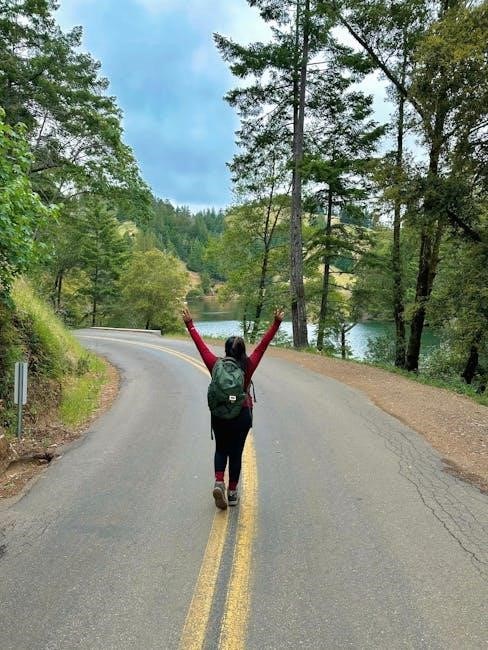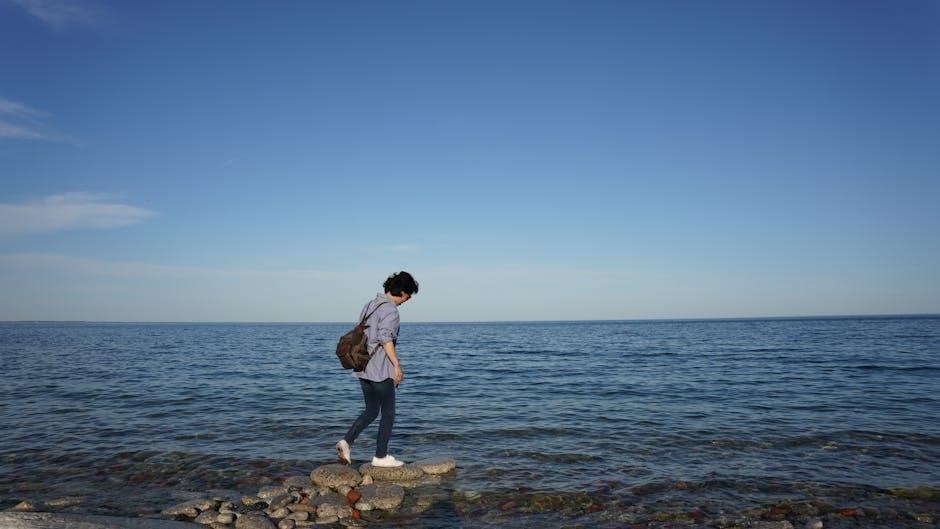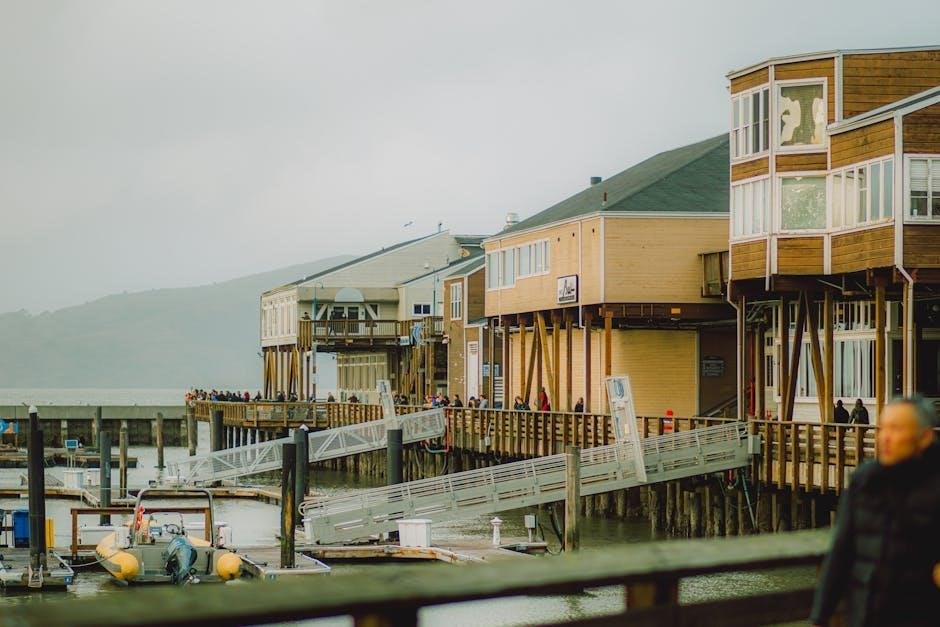
The Bay of Fires, on Tasmania’s northeastern coast, is renowned for its pristine beaches, orange-lichened rocks, and stunning coastal scenery. A self-guided walk offers an immersive way to explore this natural wonder, with its unique geological formations and untouched landscapes attracting outdoor enthusiasts worldwide.
Geographical Location
The Bay of Fires is situated on the northeastern coast of Tasmania, stretching approximately 50 kilometers from Eddystone Point in the north to Binalong Bay in the south. This stunning region is divided into three distinct sections, each offering unique landscapes. The northern section begins at Boulder Point, while the middle and southern sections extend toward the scenic town of St. Helens. Known for its pristine beaches, turquoise waters, and iconic orange-lichened rocks, the Bay of Fires is a remote and breathtaking destination that attracts outdoor enthusiasts for its untouched natural beauty and diverse wildlife. Its location along Tasmania’s East Coast makes it easily accessible for self-guided walkers seeking an immersive experience in nature.
Unique Features
The Bay of Fires is distinguished by its pristine white-sand beaches, crystal-clear turquoise waters, and distinctive orange-lichened rocks that line the coastline. These vibrant rock formations, created by lichen growth, give the area its striking appearance. The region’s untouched natural beauty, combined with its remote location, offers a serene and immersive environment for walkers. The Bay of Fires is also rich in diverse wildlife, including native kangaroos and seabirds, making it a haven for nature enthusiasts. Its unique landscapes, ranging from sandy dunes to rugged coastlines, provide a captivating backdrop for a self-guided walking adventure. The area’s isolation ensures an unspoiled experience, allowing walkers to connect deeply with Tasmania’s pristine wilderness.
Brief History
The Bay of Fires derives its name from the numerous fires spotted by European settlers, lit by the local Aboriginal people, which suggested a densely populated region. The area has a rich Indigenous history, with the Palawa people being its original inhabitants. These fires were part of their land management and cultural practices. Over time, the region became known for its natural beauty and unique geological features. Today, the Bay of Fires is celebrated for its pristine beaches and distinctive red-lichened rocks, attracting visitors from around the world. Its history blends Indigenous heritage with European exploration, creating a fascinating narrative that underpins its allure as a walking destination.

Benefits of Self-Guided Walking in Tasmania
Self-guided walking in Tasmania offers unparalleled flexibility and independence, allowing travelers to immerse themselves in pristine landscapes at their own pace, fostering a deeper connection with nature and culture.
Flexibility and Independence
A self-guided Bay of Fires walk offers the ultimate freedom to explore Tasmania’s stunning coastline at your own pace. With detailed maps and itineraries provided, you can navigate the well-marked trails with ease, allowing you to immerse yourself in the breathtaking scenery without the constraints of a group tour. This approach enables you to create a personalized experience, stopping to admire hidden coves, enjoying the serene beaches, or simply taking a moment to connect with nature; The independence of a self-guided adventure ensures a seamless and stress-free journey, letting you focus on the beauty of the Bay of Fires and the joy of discovery.
Immersive Experience
A self-guided Bay of Fires walk offers an unparalleled opportunity to fully immerse yourself in Tasmania’s pristine landscapes. Walking along the coastline, you’ll encounter the iconic orange-lichened rocks, crystal-clear waters, and pristine white sandy beaches that define this region. The absence of strict tour schedules allows you to deeply connect with the natural environment, explore hidden coves, and absorb the serenity of the area. As you traverse through Mt. William National Park and the Blue Tier Reserve, you’ll encounter native wildlife, including kangaroos, and experience the untouched beauty of Tasmania’s wilderness. This immersive journey ensures a memorable and transformative experience, leaving you with lasting impressions of the Bay of Fires’ unique charm and natural splendor.

Detailed Itinerary of the Bay of Fires Walk
The 4-day Bay of Fires Walk begins at Entally Lodge, transferring to Boulder Point. Days include exploring Mt. William National Park, Forester Beach Camp, and ending at Ansons Bay, covering 28km.
Day 1: Arrival and Initial Exploration
Day 1 begins with arrival at Entally Lodge, where a thorough gear check is conducted. Participants then take a scenic coach ride to Boulder Point, passing through Derby and Scottsdale. The walk starts along the beach, where the unique “squeaky” white sand offers a memorable experience. The initial exploration introduces walkers to the stunning coastal scenery, setting the tone for the adventure ahead. This day is about settling into the rhythm of the walk and absorbing the natural beauty of Tasmania’s northeast coast. The ease of the trail allows walkers to acclimate to the environment, preparing them for the days to come.
Day 2: Exploring Mt. William National Park
Day 2 begins with a hearty breakfast before embarking on a 9km, 4-hour walk through Mt. William National Park. The trail leads through pristine beaches and into sand dunes, offering breathtaking views of Tasmania’s coastline. Keep an eye out for native wildlife, including kangaroos, which are frequently spotted in this area. The walk is guided, providing insights into the region’s history and ecosystems. After a morning of exploration, arrive at Forester Beach Camp, where a gourmet dinner awaits. Relax in the comfort of semi-permanent tents nestled among the dunes, surrounded by the tranquil sounds of nature. This day combines adventure with relaxation, setting the stage for the journey ahead.
Day 3: Coastal Adventure and Relaxation
Day 3 offers a mix of adventure and relaxation as you explore the stunning coastline. The morning begins with a walk along high sand dunes and red lichen-covered boulders, iconic to the Bay of Fires. Guided by knowledgeable experts, you’ll learn about the area’s history, including Aboriginal tales and the origin of its name. A visit to the Eddystone Point Lighthouse provides panoramic views and insight into the region’s maritime past. After a beachside lunch, you’ll arrive at the exclusive Bay of Fires Lodge, your home for the next two nights. Spend the afternoon unwinding with a spa treatment, a dip in the sea, or exploring the lodge’s serene surroundings. This day balances exploration with relaxation, allowing you to fully immerse yourself in Tasmania’s coastal beauty.
Day 4: Final Day and Departure
Your final day begins with a leisurely morning at the Bay of Fires Lodge, where you can enjoy a relaxing walk or a refreshing swim. After breakfast, you’ll embark on a short, scenic coastal walk to the pickup point, winding through a unique forest track. A final lunch amidst gum trees marks the end of your journey. Upon arrival at Entally Lodge, you’ll have the opportunity to share stories and toast your adventure with fellow travelers. A shuttle service will then transport you back to Launceston or the airport, bringing your incredible Bay of Fires experience to a close. This day is a perfect blend of reflection and farewell, leaving you with lasting memories of Tasmania’s pristine coastline.

Accommodation Options for the Self-Guided Walk
Choose from eco-lodges, campsites, or budget-friendly options, each offering convenience and essential amenities, ensuring a comfortable stay during your Bay of Fires adventure.
Eco-Lodges and Campsites
Eco-lodges and campsites in the Bay of Fires region offer a perfect blend of comfort and connection with nature. These accommodations are designed to minimize environmental impact while providing luxurious amenities. The Bay of Fires Lodge and Forester Beach Camp are standout options, offering semi-permanent tents with modern comforts and stunning coastal views. These eco-friendly retreats are strategically located to allow easy access to walking trails, ensuring a seamless experience for self-guided explorers. With their focus on sustainability, these lodgings provide a unique opportunity to immerse yourself in Tasmania’s pristine landscapes while enjoying the convenience of well-equipped facilities. Whether you prefer luxury or simplicity, these options cater to diverse preferences, making your Bay of Fires adventure both memorable and environmentally conscious.
Budget-Friendly Alternatives
For those seeking affordable options, budget-friendly alternatives near the Bay of Fires include camping sites and holiday parks in nearby towns like Binalong Bay or St. Helens. These options provide basic yet comfortable accommodations, allowing walkers to immerse themselves in nature without the cost of luxury lodges. Camping under the stars offers a unique connection to the environment, while holiday parks often include amenities like shared kitchens and laundry facilities. Budget-conscious travelers can also opt for self-catering cabins or guesthouses, which provide flexibility and cost savings. These alternatives enable walkers to enjoy the stunning coastal scenery and trails of the Bay of Fires at a more affordable price, making the experience accessible to a wider range of visitors.

Essential Packing List for the Walk
A sturdy hiking pack, waterproof jacket, comfortable shoes, layered clothing, hat, sunscreen, water bottle, and phone for navigation are must-haves for the Bay of Fires self-guided walk.
Clothing and Footwear
For the Bay of Fires self-guided walk, wear comfortable, breathable clothing suitable for varying weather conditions. Layers are essential to adapt to Tasmania’s unpredictable climate. Moisture-wicking fabrics and a waterproof jacket are must-haves. Sturdy, ankle-high hiking boots with good tread are crucial for the uneven terrain and sandy dunes. Bring socks made of durable, moisture-wicking materials to prevent blisters. A hat, sunglasses, and gloves provide protection from sun and wind. Avoid cotton as it retains moisture; opt for synthetic or woolen blends instead. Pack lightweight, quick-drying pants and tops for ease of movement; Include a warm fleece for cooler mornings and evenings. Ensure all clothing is weather-resistant to withstand potential rain and coastal winds.
Navigation and Safety Gear
Carry detailed maps and trail notes provided for the Bay of Fires self-guided walk to navigate the well-marked trails with ease. A compass and GPS device are essential for tracking your route, especially in remote areas. Include a first-aid kit with basics for treating minor injuries. Bring a whistle for emergencies and a headlamp for early mornings or late evenings. A personal locator beacon (PLB) is recommended for solo hikers in case of remote emergencies. Pack sunscreen and insect repellent to protect against sun and insects. Ensure your phone is fully charged, and consider a portable power bank for extended trips. These items ensure safety and confidence during your self-guided adventure along Tasmania’s stunning coastline.

Safety Tips and Precautions
Always plan for emergencies, check weather forecasts, and stay on marked trails. Carry sufficient water, inform someone of your itinerary, and be prepared for remote conditions.
Emergency Preparedness
Always carry a first aid kit, emergency shelter, and a communication device. Pack extra water, food, and a whistle for signaling. Know the emergency contact numbers and have a map. Stay visible by wearing bright clothing and avoid wandering off trails. In case of an emergency, remain calm and stay in one place to make it easier for rescuers to locate you. Check the weather forecast before heading out and inform someone about your itinerary. Be prepared for remote conditions with limited phone reception. Ensure you have a headlamp or torch in case of unexpected delays. Familiarize yourself with basic first aid and know how to use your gear properly.
Environmental Considerations
The Bay of Fires is a fragile and pristine environment, requiring careful preservation. Minimize waste by carrying reusable containers and ensuring all rubbish is taken with you. Stay on designated trails to protect native flora and avoid disturbing wildlife. Be mindful of sensitive coastal ecosystems and avoid removing rocks or plants. Refrain from feeding wildlife to maintain their natural behaviors. Always carry a reusable water bottle to reduce plastic use. Respect any protected areas or restrictions in place. By adhering to these guidelines, you help preserve the Bay of Fires’ natural beauty for future visitors. Every small action contributes to maintaining this stunning environment.
Cultural and Historical Significance
The Bay of Fires holds profound cultural significance, named after fires lit by Aboriginal people, reflecting Tasmania’s rich Indigenous history and European settlement encounters.
Indigenous History

The Bay of Fires is deeply rooted in the history and culture of Tasmania’s Indigenous peoples. The area was first inhabited by the Palawa Aboriginal community, whose connection to the land spans thousands of years. European settlers were drawn to the region after spotting numerous fires lit by Aboriginal people along the coast, which led to the area’s naming. These fires were not only for warmth and food preparation but also for land management and communication. Today, visitors on the self-guided walk can learn about the rich cultural heritage and the significance of the land to its original inhabitants through guided tours and interpretive signage.

Booking and Cost Considerations
Prices for the Bay of Fires Walk Self-Guided vary by season, starting from $2,395 per person. Packages include transfers, meals, and eco-lodge stays, with gear rental options available.
Budgeting Tips
Planning ahead is key to managing costs for the Bay of Fires Walk Self-Guided. Prices start at $2,395 per person, inclusive of meals, transfers, and accommodation. Consider traveling during the off-peak season (October–May) for potential discounts. Packing wisely can save money; check the provided packing list to avoid unnecessary purchases. Opting for budget-friendly accommodations near the trail can reduce expenses. Additionally, booking early ensures availability and may offer better rates. Finally, budget for additional costs like transportation to Tasmania and any pre- or post-walk activities. Seeking package deals or discounts can further optimize your budget for this unforgettable adventure.

Extended Exploration Beyond the Walk
Explore beyond the Bay of Fires by discovering nearby attractions like the Blue Tier National Reserve, offering additional hiking trails and scenic views. Extend your trip to uncover Tasmania’s hidden gems, including local wildlife and picturesque coastal towns, perfect for fishing and birdwatching enthusiasts.
Nearby Attractions
Beyond the Bay of Fires, explore the Blue Tier National Reserve, offering stunning hiking trails and panoramic views. Visit Binalong Bay, a charming coastal village with access to pristine beaches. Discover the historic Eddystone Point Lighthouse, a landmark with breathtaking ocean vistas. Nearby, the town of St. Helens provides a gateway to local cuisine and fishing spots. For adventure seekers, the Mount William National Park and Scottsdale’s scenic landscapes are within reach. These attractions complement the Bay of Fires experience, offering a mix of nature, history, and relaxation for travelers seeking to extend their Tasmanian adventure.

Tips and Tricks for a Successful Trek
Plan with detailed maps and GPS for navigation. Wear sturdy footwear for uneven terrain. Stay hydrated, carry snacks, and respect the environment to enhance your Bay of Fires experience.
Navigation Tips
For a seamless self-guided Bay of Fires Walk, use detailed maps and GPS devices to stay on track. Familiarize yourself with trail markers and landmarks beforehand. Carry a compass as a backup and download offline maps to avoid signal issues. Plan your route in advance, noting key checkpoints like beaches and headlands. Pay attention to tidal changes, as some sections may require low tide crossings. Keep your phone charged for emergencies, but rely primarily on physical navigation tools. Always inform someone of your itinerary and estimated return time. By staying prepared and vigilant, you can confidently navigate the stunning Bay of Fires trails.
Health and Wellness
Ensuring your health and wellness is crucial for a successful self-guided Bay of Fires Walk. Stay hydrated by carrying at least 2-3 liters of water per day and refill at designated points. Apply sunscreen regularly and wear protective clothing to shield against Tasmania’s strong UV rays. Pack energy-rich snacks and meals to maintain your energy levels throughout the day. Be mindful of your physical limits and take regular breaks to rest and recover. First aid kits are essential; include supplies for blisters, sprains, and minor injuries. Consider any personal health conditions and plan accordingly, such as carrying necessary medications. A well-prepared approach ensures you can fully enjoy the breathtaking beauty of the Bay of Fires while maintaining your well-being.
Leave a Reply
You must be logged in to post a comment.